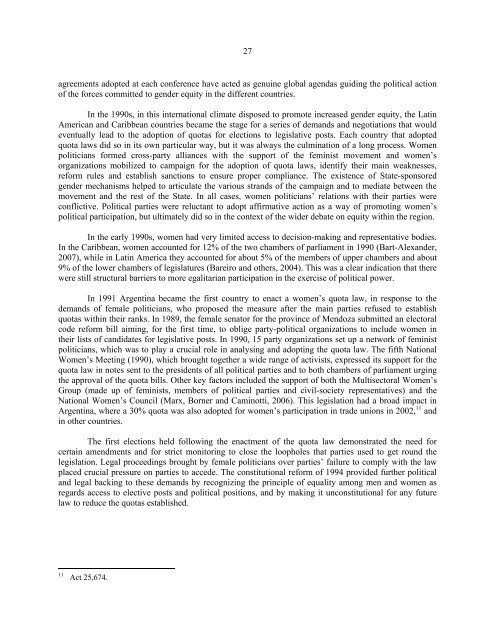Women in Latin America and the Caribbean - Cepal
Women in Latin America and the Caribbean - Cepal
Women in Latin America and the Caribbean - Cepal
You also want an ePaper? Increase the reach of your titles
YUMPU automatically turns print PDFs into web optimized ePapers that Google loves.
27<br />
agreements adopted at each conference have acted as genu<strong>in</strong>e global agendas guid<strong>in</strong>g <strong>the</strong> political action<br />
of <strong>the</strong> forces committed to gender equity <strong>in</strong> <strong>the</strong> different countries.<br />
In <strong>the</strong> 1990s, <strong>in</strong> this <strong>in</strong>ternational climate disposed to promote <strong>in</strong>creased gender equity, <strong>the</strong> Lat<strong>in</strong><br />
<strong>America</strong>n <strong>and</strong> <strong>Caribbean</strong> countries became <strong>the</strong> stage for a series of dem<strong>and</strong>s <strong>and</strong> negotiations that would<br />
eventually lead to <strong>the</strong> adoption of quotas for elections to legislative posts. Each country that adopted<br />
quota laws did so <strong>in</strong> its own particular way, but it was always <strong>the</strong> culm<strong>in</strong>ation of a long process. <strong>Women</strong><br />
politicians formed cross-party alliances with <strong>the</strong> support of <strong>the</strong> fem<strong>in</strong>ist movement <strong>and</strong> women’s<br />
organizations mobilized to campaign for <strong>the</strong> adoption of quota laws, identify <strong>the</strong>ir ma<strong>in</strong> weaknesses,<br />
reform rules <strong>and</strong> establish sanctions to ensure proper compliance. The existence of State-sponsored<br />
gender mechanisms helped to articulate <strong>the</strong> various str<strong>and</strong>s of <strong>the</strong> campaign <strong>and</strong> to mediate between <strong>the</strong><br />
movement <strong>and</strong> <strong>the</strong> rest of <strong>the</strong> State. In all cases, women politicians’ relations with <strong>the</strong>ir parties were<br />
conflictive. Political parties were reluctant to adopt affirmative action as a way of promot<strong>in</strong>g women’s<br />
political participation, but ultimately did so <strong>in</strong> <strong>the</strong> context of <strong>the</strong> wider debate on equity with<strong>in</strong> <strong>the</strong> region.<br />
In <strong>the</strong> early 1990s, women had very limited access to decision-mak<strong>in</strong>g <strong>and</strong> representative bodies.<br />
In <strong>the</strong> <strong>Caribbean</strong>, women accounted for 12% of <strong>the</strong> two chambers of parliament <strong>in</strong> 1990 (Bart-Alex<strong>and</strong>er,<br />
2007), while <strong>in</strong> Lat<strong>in</strong> <strong>America</strong> <strong>the</strong>y accounted for about 5% of <strong>the</strong> members of upper chambers <strong>and</strong> about<br />
9% of <strong>the</strong> lower chambers of legislatures (Bareiro <strong>and</strong> o<strong>the</strong>rs, 2004). This was a clear <strong>in</strong>dication that <strong>the</strong>re<br />
were still structural barriers to more egalitarian participation <strong>in</strong> <strong>the</strong> exercise of political power.<br />
In 1991 Argent<strong>in</strong>a became <strong>the</strong> first country to enact a women’s quota law, <strong>in</strong> response to <strong>the</strong><br />
dem<strong>and</strong>s of female politicians, who proposed <strong>the</strong> measure after <strong>the</strong> ma<strong>in</strong> parties refused to establish<br />
quotas with<strong>in</strong> <strong>the</strong>ir ranks. In 1989, <strong>the</strong> female senator for <strong>the</strong> prov<strong>in</strong>ce of Mendoza submitted an electoral<br />
code reform bill aim<strong>in</strong>g, for <strong>the</strong> first time, to oblige party-political organizations to <strong>in</strong>clude women <strong>in</strong><br />
<strong>the</strong>ir lists of c<strong>and</strong>idates for legislative posts. In 1990, 15 party organizations set up a network of fem<strong>in</strong>ist<br />
politicians, which was to play a crucial role <strong>in</strong> analys<strong>in</strong>g <strong>and</strong> adopt<strong>in</strong>g <strong>the</strong> quota law. The fifth National<br />
<strong>Women</strong>’s Meet<strong>in</strong>g (1990), which brought toge<strong>the</strong>r a wide range of activists, expressed its support for <strong>the</strong><br />
quota law <strong>in</strong> notes sent to <strong>the</strong> presidents of all political parties <strong>and</strong> to both chambers of parliament urg<strong>in</strong>g<br />
<strong>the</strong> approval of <strong>the</strong> quota bills. O<strong>the</strong>r key factors <strong>in</strong>cluded <strong>the</strong> support of both <strong>the</strong> Multisectoral <strong>Women</strong>’s<br />
Group (made up of fem<strong>in</strong>ists, members of political parties <strong>and</strong> civil-society representatives) <strong>and</strong> <strong>the</strong><br />
National <strong>Women</strong>’s Council (Marx, Borner <strong>and</strong> Cam<strong>in</strong>otti, 2006). This legislation had a broad impact <strong>in</strong><br />
Argent<strong>in</strong>a, where a 30% quota was also adopted for women’s participation <strong>in</strong> trade unions <strong>in</strong> 2002, 11 <strong>and</strong><br />
<strong>in</strong> o<strong>the</strong>r countries.<br />
The first elections held follow<strong>in</strong>g <strong>the</strong> enactment of <strong>the</strong> quota law demonstrated <strong>the</strong> need for<br />
certa<strong>in</strong> amendments <strong>and</strong> for strict monitor<strong>in</strong>g to close <strong>the</strong> loopholes that parties used to get round <strong>the</strong><br />
legislation. Legal proceed<strong>in</strong>gs brought by female politicians over parties’ failure to comply with <strong>the</strong> law<br />
placed crucial pressure on parties to accede. The constitutional reform of 1994 provided fur<strong>the</strong>r political<br />
<strong>and</strong> legal back<strong>in</strong>g to <strong>the</strong>se dem<strong>and</strong>s by recogniz<strong>in</strong>g <strong>the</strong> pr<strong>in</strong>ciple of equality among men <strong>and</strong> women as<br />
regards access to elective posts <strong>and</strong> political positions, <strong>and</strong> by mak<strong>in</strong>g it unconstitutional for any future<br />
law to reduce <strong>the</strong> quotas established.<br />
11<br />
Act 25,674.











